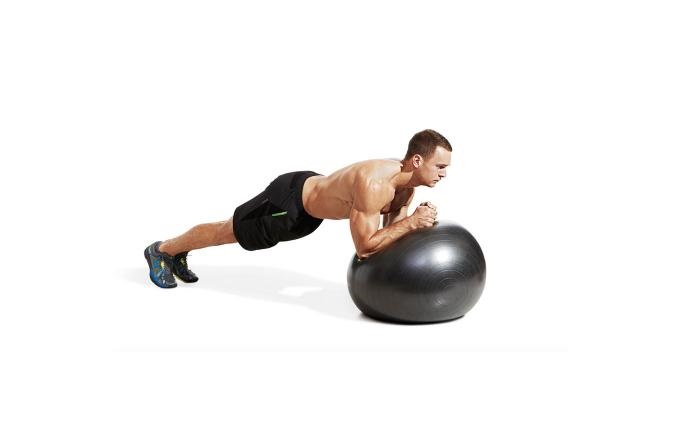This article will cover everything you need to know to add and properly execute the Swiss Ball Plank into your training routine.
This article will include a video, image and a written step by step description on how to do this exercise.
Its difficulty level, the equipment you need to do it. The different muscle groups that get worked when you use this exercise.
The benefits you get when adding it to your training routine. Also, some different training cues to use when you are performing it.
Do not add this lift to your training yet if you cannot hold a traditional plank for at least 15 seconds.
Swiss Ball Plank How to Guide
Image Example

Step by Step Description
Step 1: Move into the plank position by Placing your chest, elbows, and forearms onto the swiss ball. Extend your legs and support your body with the tows.
Step 2: Now lift your chest off of the Swiss ball, so only your forearms are supporting your upper body.
Step 3: Keep your core tight, contract your glutes, and legs and have your body form a straight line from the shoulders to your heels.
Hold this position for as long as you can without any sagging or arching happening at your hips. Once you can hold the lift for 1 minute, you should add additional weight with a weighted vest. Alternatively, you can move to a more challenging plank variation like the swiss ball plank circle.
Difficulty Level
This lift is an advanced plank variation that will strengthen your core, lower back, and entire upper body.
If you want to increase the difficulty, put your feet close together, or you can even lift one of your feet off of the floor.
Another way you can make this exercise more challenging is by having your feet on a stool or bench. Having your feet placed higher reduces your stability and will recruit an even more significant amount of your abdominals stabilizing muscles.
If you are looking to make the exercise a little easier, just spread your legs wider apart. Spreading your legs will create a broader base of support reducing the amount of core support required.
Equipment Required
You will need access to a Swiss ball to add this exercise to your training routine.
To continue making this lift harder a weighted vest is a useful piece of equipment to use with calisthenics exercises like this one. A stool or weighted bench may also be required if you plan to use the variation where you raise your feet in line with the shoulders.
Muscles Worked
The Primary muscles involved are your Abdominals and the Obliques.
The secondary muscles that get recruited are your Glutes, Hamstrings, the Back and your arms.
Benefits of the Swiss Ball Plank
Since you are on an unstable surface while you perform the plank, more of your abdominal muscles get recruited.
Your body stabilizer muscles are much more active with this exercise compared to the traditional variation.
Building a strong core will help you on other compound movements like the Deadlift and Squat.
Having a strong core can help to reduce back pain and limit your chance of receiving a lower back injury.
Training Tips
Drive your elbows and forearms into the Swiss ball as hard as you can.
Make sure that your hips do not sag at any time when you are performing this exercise.
Squeezing your glutes is essential and will help to stabilize and prevent your body from rotating to one side.
In Closing
Core development is essential and should not get neglected in your training routines.
Having a strong core is a critical factor to many other compound lifts like deadlift or squats and limits your chance of receiving a back injury.
If you are getting tired of the traditional plank and looking for something more challenging, then you should test out the Swiss Ball Plank to challenge your core.
Exercises you may Also Like
Rolling Side Plank
Plank Knee to Elbow
Plank Rotation
Reference
Looking to gain more strength or lose some weight? We offer free fitness tools to help you reach your fitness goals. Register for free while we are in beta and get free lifetime access to our fitness tools that include an easy to use Calorie Counter, High-Intensity Interval Timer, Multiple Fitness Calculators and our Exercise Logger.